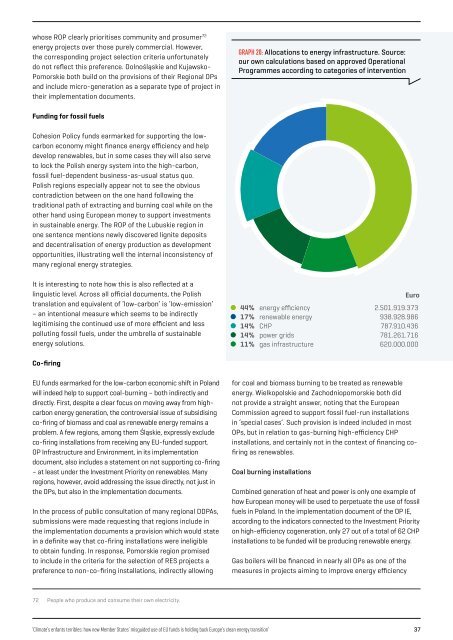ENFANTS TERRIBLES
enfants-terribles
enfants-terribles
You also want an ePaper? Increase the reach of your titles
YUMPU automatically turns print PDFs into web optimized ePapers that Google loves.
whose ROP clearly prioritises community and prosumer 72<br />
energy projects over those purely commercial. However,<br />
the corresponding project selection criteria unfortunately<br />
do not reflect this preference. Dolnośląskie and Kujawsko-<br />
Pomorskie both build on the provisions of their Regional OPs<br />
and include micro-generation as a separate type of project in<br />
their implementation documents.<br />
GRAPH 20: Allocations to energy infrastructure. Source:<br />
our own calculations based on approved Operational<br />
Programmes according to categories of intervention<br />
Funding for fossil fuels<br />
Cohesion Policy funds earmarked for supporting the lowcarbon<br />
economy might finance energy efficiency and help<br />
develop renewables, but in some cases they will also serve<br />
to lock the Polish energy system into the high-carbon,<br />
fossil fuel-dependent business-as-usual status quo.<br />
Polish regions especially appear not to see the obvious<br />
contradiction between on the one hand following the<br />
traditional path of extracting and burning coal while on the<br />
other hand using European money to support investments<br />
in sustainable energy. The ROP of the Lubuskie region in<br />
one sentence mentions newly discovered lignite deposits<br />
and decentralisation of energy production as development<br />
opportunities, illustrating well the internal inconsistency of<br />
many regional energy strategies.<br />
It is interesting to note how this is also reflected at a<br />
linguistic level. Across all official documents, the Polish<br />
translation and equivalent of ‘low-carbon’ is ‘low-emission’<br />
– an intentional measure which seems to be indirectly<br />
legitimising the continued use of more efficient and less<br />
polluting fossil fuels, under the umbrella of sustainable<br />
energy solutions.<br />
Euro<br />
44% energy efficiency 2.501.919.373<br />
17% renewable energy 938.928.986<br />
14% CHP 787.910.436<br />
14% power grids 781.261.716<br />
11% gas infrastructure 620.000.000<br />
Co-firing<br />
EU funds earmarked for the low-carbon economic shift in Poland<br />
will indeed help to support coal-burning – both indirectly and<br />
directly. First, despite a clear focus on moving away from highcarbon<br />
energy generation, the controversial issue of subsidising<br />
co-firing of biomass and coal as renewable energy remains a<br />
problem. A few regions, among them Śląskie, expressly exclude<br />
co-firing installations from receiving any EU-funded support.<br />
OP Infrastructure and Environment, in its implementation<br />
document, also includes a statement on not supporting co-firing<br />
– at least under the Investment Priority on renewables. Many<br />
regions, however, avoid addressing the issue directly, not just in<br />
the OPs, but also in the implementation documents.<br />
In the process of public consultation of many regional DDPAs,<br />
submissions were made requesting that regions include in<br />
the implementation documents a provision which would state<br />
in a definite way that co-firing installations were ineligible<br />
to obtain funding. In response, Pomorskie region promised<br />
to include in the criteria for the selection of RES projects a<br />
preference to non-co-firing installations, indirectly allowing<br />
for coal and biomass burning to be treated as renewable<br />
energy. Wielkopolskie and Zachodniopomorskie both did<br />
not provide a straight answer, noting that the European<br />
Commission agreed to support fossil fuel-run installations<br />
in ‘special cases’. Such provision is indeed included in most<br />
OPs, but in relation to gas-burning high-efficiency CHP<br />
installations, and certainly not in the context of financing cofiring<br />
as renewables.<br />
Coal burning installations<br />
Combined generation of heat and power is only one example of<br />
how European money will be used to perpetuate the use of fossil<br />
fuels in Poland. In the implementation document of the OP IE,<br />
according to the indicators connected to the Investment Priority<br />
on high-efficiency cogeneration, only 27 out of a total of 62 CHP<br />
installations to be funded will be producing renewable energy.<br />
Gas boilers will be financed in nearly all OPs as one of the<br />
measures in projects aiming to improve energy efficiency<br />
72<br />
People who produce and consume their own electricity.<br />
‘Climate’s enfants terribles: how new Member States’ misguided use of EU funds is holding back Europe’s clean energy transition’ 37


